Despite extensive use of our gardening tools for various gardening projects, we sometimes forget to give our gardening tools proper cleaning and care. There is nothing more pleasing for a dedicated gardener than to keep his tools clean and in good shape. Finding your tools all rusted can be frustrating; here’s how to remove rust from your tools and keep them in prime condition.
How to Clean Rust From Pruning Tools?
Tools You Need
- A bucket of water
- A piece of clean cloth
- A wire or stiff haired scrubbing brush
- A knife sharpener
- Vinegar
- Oil or lubricant, e.g. WD-40
Step-by-step Rust Removal Process
Below are some easy and simple steps for you to follow to get rid of rust and clean your tools:
- The first thing we need is a mason jar and some white distilled vinegar. Vinegar is acidic, so if you leave your rusted tool in the vinegar bath for about 24 hours, it will start to eat away the rust.
- Afterwards, use a scrub pad to remove any remaining rust. Make sure you clean every inch of the rusted tool.
- Use a dry cloth to wipe the scrubbed tool and remove moisture from it.
- Lastly, apply some oil. By treating your tool with oil, you will lubricate its moving parts and add a protective coat over it.
If you keep your tools clean and protected from rust, they can last longer. The rust removal process is effective, but it might get tedious to perform it every time, which is why preventing tools from rusting is the best way around.

How to Prevent My Garden Tools from Rusting?
Preventing your garden tools from rusting is quite easy. Ensure that you clean your tools properly after every use. Regular cleaning of mud, dirt, and build-up like tree sap from your tools is necessary. Many gardeners clean their tools with a coarse metal brush or dry cloth as these materials effectively remove residue as well. For ideal outcomes, make your cleaning blend by mixing a little water with a dish cleanser or pine sol. Once cleaned, you should dry your gardening tools and rub them with mineral oil.
Another important step to prevent pruners and garden tools from rusting is proper storage. The ideal area for your tools should have low moisture levels. However, this isn’t the only trick! Some experienced gardeners have another hack of sorts. According to them, storing digging tools with their cutting edges down in a compartment loaded up with sand and mineral spirits keeps them safe from unsavoury shocks, like rust, for quite a while. Moreover, tools also benefit from routine spraying with WD-40 – an oil designed to protect the metal from rust and corrosion.
Some other steps to follow to prevent your garden tools from rusting are:
Make a Habit of Cleaning Your Garden Tools After Each Use
If any of your tools have dried soil build-up, use a wire brush and give them a decent scouring. If required, soak or submerge the tools in a bucket of warm water to remove hardened soil. Different tree trimming tools like pruning shears or trimmers must be cleaned regularly as well. If there’s sap on these tools, you will have to put in extra effort to clean them. Dipping the tools in warm water is mostly sufficient to remove sap. However, if this doesn’t work, you can use WD-40, Pine-Sol, or a dissolvable that is explicitly used for dissolving plant sap.

Sharpening and Sanding of the Tools
Sanding down wooden handles helps eliminate splinters and smooths out the harsh, raised grains that appear when wood gets wet. Most digging tools like pruning shears, trimmers, spades, cultivators, and hand scoops, have metal edges. Keeping these cutting edges sharp is necessary for maintaining the usability of these tools. Sharp edges make smooth and clean cuts in one go to ensure that the plant is not distressed under the sawing action of a dull tool. The swift actions of a sharp-edged tool also make the work of the gardener easier.
To sharpen digging tools, you need a mill file. A mill file is a long, level metal record. Lay the gardening tool such as a pruner with its base flat against the mill file. Hold the pruner with both hands and push it along the edge of the file in downwards motion. Put light and even pressure on the tool; the mill file only sharpens the tool edge when you push the tool. Repeat this process and make a few strokes against the mill file until the desired sharpness is achieved. Afterwards, use 300 pebble sandpaper to eliminate any burr sticking to the sharpened blade.
Oil Your Garden Tools
As mentioned earlier, garden tools can easily rust from sap and residue build-up on the cutting edges. To prevent this, use a firm brush or scrubby pad to remove soil and sap from the edges’ crevices. Once the residue build-up is removed, wash the cutting edges with warm foamy water and dry them completely afterwards.
When the tool is completely dry, apply a couple of drops of lubricating oil like WD oil or engine oil to the axis and edges. Wipe off the extra oil with a clean towel. Use an old piece of cloth or towel to generously apply oil all over the metal and wooden pieces of your tools, and let them sit for around 15 minutes before rubbing them dry. Oiling keeps the metal from rusting and the wood from breaking. It is very effective in maintaining the prime condition of your tools.
Sanitize Your Tools
Sanitizing does not increase your tools’ life, but it is quite beneficial for the garden. Disinfecting will free your tools from microbial and fungal growths, preventing germ transfer to the plants while tending to them. To make a disinfectant, mix one section of bleach to 10 sections of water in a bucket. After thoroughly mixing the two, wash each tool with this liquid. Afterwards, completely dry your tools in the sun or use a towel to pat them dry.

Store Your Tools Properly
Dry climate is an absolute necessity for storing your tools. In a dry place, hang your tools on a wall or via a wire. Tools that are either placed lying on their sharp edges or thrown into a heap with other tools are more vulnerable to rusting and breakage. Putting away tools in a container of sand and vegetable oil can help forestall rust and keep your tools clean. Moreover, grains of sand are rough against the edges, which helps keep the tools sharp. Another remedy is to blend about a half-gallon of vegetable oil into five gallons of sand and push any tools with edges into this mixture to prevent rusting and maintain sharpness.
Conclusion
Dedicated gardeners looking for ways to protect their tools from rusting and dullness no longer have to worry. This article has instated plenty of ways to prevent rusting of tools and remove existing rust. By following these methods, you can prevent your tools from getting damaged and simplify the cleaning task. All these tips will help you maintain your pruners and garden tools’ sharpness and elongate their working life.


